CRMC’s public awareness is listing and not to the public’s side
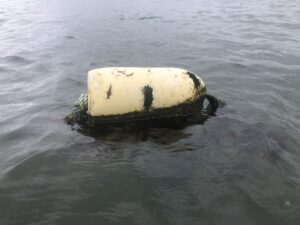
Corner marker for proposed shellfish aquaculture lease site in Tiverton, RI
“They have such a head start,” said Tiverton resident Ken Mendez, waist deep in an incoming Sakonnet River tide. Casting a fly rod southwest, he aimed to fool a striped bass feeding near the Seapowet Bridge and not foul hook a yellow corner buoy without numbers, marking a proposed shellfish aquaculture business. Mr. Mendez and others have fished this small river mouth for years at all hours, in all conditions, where people also swim and paddle kayaks. In March of 2020, John and Patrick Bowen applied to the Coastal Resources Management Council (CRMC) to lease .95 acres of public waters to grow Eastern oysters there. Nearing completion of the process, there is considerable, rising opposition to the lease but more so, calls for improving CRMC’s public awareness of a gated system which permits businesses in public waters in front of people’s homes without ever speaking with them, leaving abutters and historical users quite often out of the conversation.
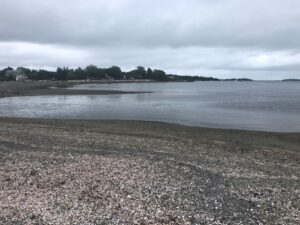
Just west of the Seapowet Marsh
“We bought this house because of the fishing,” Mr. Mendez said, looking out over the Seapowet Marsh, piles of research and computer models. He is concerned because the site is in prime fishing grounds so he’s weighed risks of waving the flag and giving up a spot. Anyone with good Yankee stock would know that place is fishy. Whether you fish, swim, hike or park to watch suns warm new days, we have secret spots for a reason. Anglers from the country’s oldest fly fishing club, the Rhody Fly Rodders and a few folks in the know, wade fish there when times and tides align. As is increasingly the case, shared State resources support many users but the question with the Bowen lease is, should one trump another, especially when one has been practiced for generations? Additionally, recreational fishing is worth approximately $412 million dollars annually in Rhode Island. In 2019, CRMC reported “the combined value of aquaculture products for consumption and seed sales was $6.07 million, down slightly from 2018 figures.” The State’s gross domestic product the same year was $61,883,800,000 so aquaculture contributed a fraction of one per cent to our economy.
Mr. Mendez’s wife Liz said, “It’s not about oyster farming, it’s about the location.” Through Tiverton’s website, Mr. Mendez learned CRMC accepted the application on 4-13-20, read of prior regulatory meetings and realized how far along the process had progressed. He and Mrs. Mendez began asking questions and speaking with neighbors and that should be a mandated, shared effort by applicants and CRMC. If the CRMC application and consideration system exists to balance all users then equal energy should be expended by applicants to inform every resident they can manage. Permitting a shellfish farm on the Sakonnet isn’t equal to opening a shoe store in General Commerce zoning where another store previously existed. The proposed Bowen site is where people fish. Given such extensive financial and emotional costs expended fighting for and against a recent aquaculture business expansion in South Kingstown, where countless abutters and recreational users learned of the application only when this column alerted them, it might have been a learning moment to reevaluate a system which fails even surrounding neighbors.
That hasn’t happened.
Letters of opposition or requesting more public noticing were received after the thirty day period which indicates friends and family knew about the application but the vast majority of residents or users of the public recreation area did not. According to the East Coast Shellfish Growers Association’s Code of Conduct for Molluscan Shellfish Culture in the Eastern United States, growers shall, “Make a best effort to communicate early and openly with water-based and land-based neighbors about any facet of their operation which might affect them.”
Peter Jenkins, owner of The Saltwater Edge, American Saltwater Guides Association Board Chair and RI Saltwater Anglers Association Access Committee representative, wrote to CRMC: “The placement of this oyster farm in an area used by recreational anglers would significantly reduce access for these anglers, especially at low tide. The RIMFC’s recent decision in a 4-3 vote to support the project was based on limited public input from recreational anglers. Many stakeholders for this project were not notified of the agenda item and were not able to provide feedback at the meeting. I learned of that meeting at 3pm on the day of the meeting.” The application system is listing and it’s not necessarily the Bowens’ fault.
With the Bowen application, there was concern regarding its proximity to shallow water so “CRMC proposed an amended site.” Why is CRMC proposing an amended site? Is the role of CRMC to evaluate specifics of a business proposed in public waters and determine if it is appropriate for the greater good which may impact existing users or to coach applicants through the process to obtain a lease? I don’t recall being coached through my last building permit application.
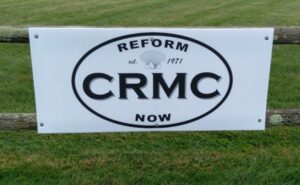
Townspeople are calling for a change at CRMC
If the job of our State regulatory body and it’s aquaculture coordinator is to assist and coach, who is the State appointed coach to help residents and abutters who have little or no background in shellfish husbandry or this waterslide application process which might land a major league business in front of their home without any prior notice? Does Rhode Island offer an ombudsman for those who feel railroaded by a process they might never have experienced? My name is on the CRMC email list so I can understand potential impacts of such applications but strangely, I never received notice of this or another larger application just north of this site, proposed by Bradley Boehringer & Travis Lundgren. I wonder why that happened.
Opposition is not always “NIMBY”
“In my opinion,” Patrick Bowen said, “most of the opposition to our farm has come from wealthy individuals who are relative newcomers to Tiverton and Rhode Island and who exemplify the NIMBY hypocrisy.” Indeed, applicants often feel frustrated when they proceed according to the rules then end up awash in last minute opposition. You will notice he said, “our farm” and not, “our application.” This case seems different because siting is only part of the issue. When good people pay good money, Tiverton’s 2020 tax rate is $16.19 per thousand, they should be afforded fair warning of a sea change to their viewshed by the very government collecting their tax dollars, which are substantially based on the value of their viewshed. Improving CRMC’s public awareness policies would hopefully prevent abutters from being ignored.
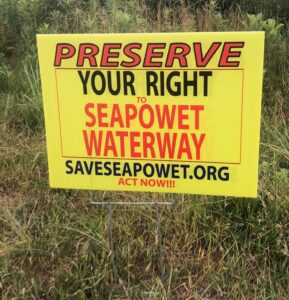
Signs of opposition can be seen throughout Tiverton
Opposition to the Bowen proposal exploded quite quickly. Yellow “Preserve Your Right to Seapowet Waterway” signs appeared near the bridge and inland. Some are the size of plywood sheets. Others call to “Reform CRMC.” On 6/30/2021, Mr. Mendez requested Attorney General Peter Neronha to, “put a stop to all oyster farm permit reviews until serious defects in the Rhode Island Coastal Resources Management Council governance structure and permitting processes can be remedied.”
“It’s not about the people,” Mrs. Mendez said. The Bowens are following rules which afford applicants cover and a head start. Their file initially included eight letters of support, none written by Tiverton residents and two of opposition received within the public comment period, both of which are from Tiverton. At a 3/1/2021 virtual Tiverton Harbors Committee meeting, Mr. Bowen stated, “There have been no letters of opposition received from adjacent property owners,” but there were letters of opposition dated as early as 5/19/2020, yet CRMC’s Aquaculture Coordinator and meeting participant, Ben Goetsch, sat silently. There is palpable frustration at how much time and effort residents have expended to mobilize against something they might not even fully understand and that is the system failing them. “People are feeling threatened, to save their property,” Mrs. Mendez said.
If improving CRMC’s public awareness had been a priority, they might encourage applicants to knock on a few doors. Mr. Bowen is justifiably concerned by last minute misinformation and a Save Seapowet website, which can be deliberate or knee-jerk from people who don’t know much, if anything, about a threat they perceive. The average homeowner likely has no knowledge of floating ADPI bags, upwellers, tumblers or trawl lines. So what happens when they feel cornered? They react, especially when there’s a clock and it’s almost done ticking.

Ken Mendez casts for striped bass in the mouth of Seapowet Marsh
And what about hunters in the marsh? In a 7-6-2021 letter to CRMC and other regulators, Backcountry Hunters & Anglers New England Chapter Board Chair, Michael Woods wrote, “Upon reviewing the application and associated documents, it is clear that impacts to hunters’ use of the area was not acknowledged, considered or addressed at any point despite the lease’s proposed location being less than 500 feet from the WMA’s boundary and the inlet to the marsh. This is shocking not only because Sapowet Marsh WMA and the adjacent waters have been used by hunters for decades, but also because over $10,000 was granted in 2015 to improve Seapowet Marsh WMA through the U.S. Fish and Wildlife Service’s Federal Aid in Wildlife Restoration Program, commonly referred to as the Pittman-Robertson Act.” Another fail in the system.
Because aquaculture applications are made for state waters and abutters are most often on town land, CRMC has no mandate to directly notify those who might be most affected. In a 6-24-2021 Sakonnet Times article, Tiverton Town Council Vice President Michael Burk, “Was leery of inserting the town into a process over which it has no regulatory authority.” And therein lies another problem. When it comes to processing aquaculture applications, which are business applications, the State and towns are convenient, distant cousins. To build a house or add a garage, you often need to notify abutters. And the permitting process is the applicant’s burden. CRMC places burdens of application monitoring and information gathering on townspeople. Meanwhile, the rest of us have to send certified letters to neighbors when we want to stand up a wood shed.
Finding no wild clams or shifting the site a few clicks only whitewashes issues of visual impact, historical uses, noise of daily business operations and obstruction to fishermen and women who want to practice their sport. Regardless of husbandry methods, aquaculture requires gear, biofouling remediation, harvest methods, timely means of live animal transportation and access to the site. Where will the Bowens maintain or store their gear? Where will the gear be cleaned and dried? Walking across a sandy beach sounds romantic but the reality of managing a lease is serious business. On April 25, 2021, Patrick M. Bowen was the Authorized Signer for Strait Landing LLC, which then purchased 0.12 acres at 701 Seapowet Way. This land would afford access to the lease, described by CRMC Coordinator Goetsch as “A small family farm.” Applying for .95 of an acre seems like a preliminary step because, given the proposed layout of trawls, it would require serious time before oysters pay for that strait strip of land.
“This is not a commercial area,” Mr. Mendez said, balancing on a piece of old carpet, peeling off his waders in a pebble and slipper shell RIDEM Seapowet parking lot. Just to the north, Bradley Boehringer and Travis Lundgren have applied for three acres to deploy floating and submerged gear in front of Clint Clemens’ home and David Rose’s third generation farm land.
“I was never notified by anybody,” Mr. Rose said of the application. He is one of the two closest land owners abutting the proposed business and only learned of the application while researching a different subject on line. In a 7-6-2021 social media post, Mr. Lundgren wrote, “The floating gear is aesthetically pleasing to someone who enjoys seeing mother nature do her best work. Wine vineyards have rows of post and fencing, our farm will have rows of floats dancing in the waves. It is a farm you can admire, engage with, or very easily steer clear due to there being minimal underwater hazards.” The application calls for gear throughout the water column and vineyards are typically terrestrial, not positioned in shared public waterways. His post leaves unclear what “engage with” might mean. As such, the same social media posts reads, “Furthermore the beach front that the farm is adjacent to is a protected coastline that is designated for sandpipers to nest. Humans are NOT permitted to use this beach and there are many signs posted by the DEM about not using the beach. The video of “north seapowet today” on the website shows people ILLEGALLY standing on the nesting grounds of an ENDANGERED species.” In fact, according to the US Fish and Wildlife Service, the only endangered or threatened bird species in Rhode Island are piping plovers, red knots and Roseate terns. The shoreline above mean high water is private property, not RIDEM land. It is posted and owned by Mr. Rose.
“There are a couple different styles of farming that we plan on doing (sic) however the style that is most discussed is our use of floating gear,”
the CRMC application cover letter states. Such a discussion is sorely missing from the process. It also states, “we will be using a gas-powered (sic) water pump to wash off the cages…” and somehow, there is no requirement, let alone any courtesy, to inform any property owner. “We look forward to hearing from other residents and we always look to be a positive influence in our community around us…establishing a business that will last generations,” they wrote, already assuming they will be in business for generations. Imagine how believable that would be if they started the process at a Groundswell Cafe table for a coffee with the neighbors to discuss their plans. Ideas and concepts would be available for all those interested and impacted. The Cafe would surely move in a few extra tables to accommodate the crowds who planted all those signs opposing the lease, which might not have happened at all if there was some basic respect and decorum. And there are a lot of signs.
How did no one even consider the hunters? What happened to New England? Are we all in on tourism at the expense of those traditions which made our part of the world so attractive to all those tourists, like fishing and hunting?
Improving CRMC’s public awareness policies has never been more important.
CRMC’s aquaculture application process is upside down
There should be at least one obvious outcome from these applications. The CRMC process for permitting aquaculture businesses is upside down. It does not stand as an impartial mediary between one group looking to lease, from the people, a shared resource. Instead it seems to coax applicants through a system lubricated with modifications to appease the few who are actually watching. How does the body managing coastal resources not alert a landowner that there might be three acres of floating plastic bags, in an era trying desperately to remove plastic from the sea, located in front of their house, abutting their moorings, disturbing their peace and in a few years, possibly changing husbandry methods or increasing lease size?
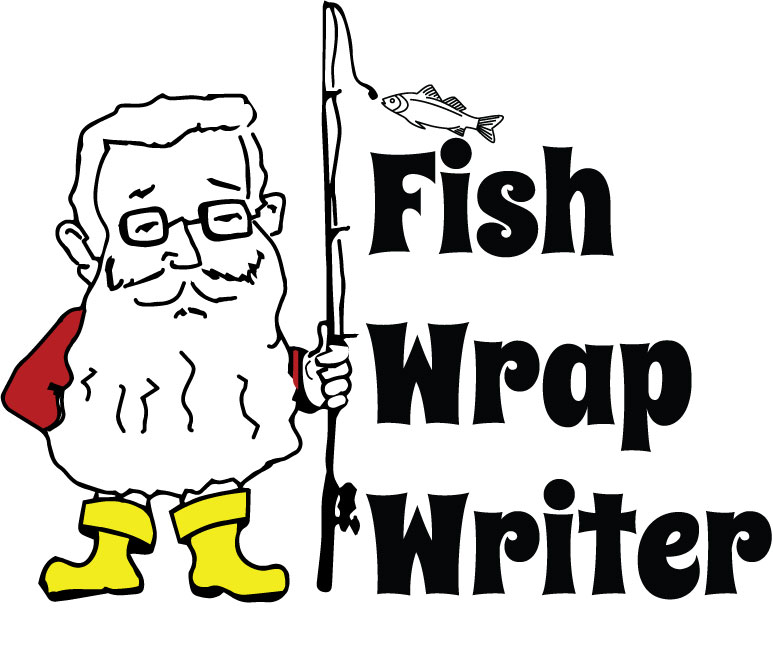


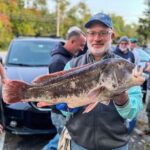


Thank you for this in-depth story. A great summary of what is going on. Change MUST happen. In the meantime, this pristine area-providing access to all-is at threat. Appreciate this coverage. -Sincerely, a very concerned neighbor on the Sakonnet River.
Thank you Erin. I hope this piece and the hard work from Tiverton residents resonates with CRMC and they adjust their policies for contacting and respecting people. And thank yo for reading Fish Wrap, I always appreciate people making time to read it. Todd
Bravo Todd. Well said. Articulated perfectly. I hope my state representative is reading your column. I will forward it forthwith.
Thank you sir. It’s time for a change in the way they solicit public input. As always, thank you for reading, I do appreciate it.
Outstanding reporting on an important topic. I wonder how many times this topic (the need for the CRMC to reach out to various stakeholders before applications are approved) will be raised before the CRMC actually does something about it. Several years ago an aquaculture farm was proposed for Segar Cove, on Potter Pond in South Kingstown. The application was submitted in January, when many stakeholders’ attention was elsewhere. It was only by chance that news of the proposal made it to the general public. The result of that public awareness was (and is) a vigorous fight to relocate the proposed farm to an area more suitable to farming, an area less prized by recreational users. If the state is genuinely interested in growing the aquaculture industry, it’s time they realized that midnight runs on favorite fishing spots, water ski holes and sailing venues is not the way to endear the process to the public.
Thank you David. I believe this piece has really opened some eyes to the way the system works and that it does not always serve the best interest of the total public. And I absolutely agree they need to a better job considering and prioritizing varying levels of importance for different users of a water body.
Your article gets to the heart of a system that is not serving the public interest. CRMC must be reformed to due their job to protect our beautiful waterways
Thank you sir. Based on responses and conversations I have had over the last few weeks, there is room for hope that change is at least being discussed. Plotting a business in someone’s front yard without ever discussing it with them is totally unacceptable.